
Facebook Twitter Instagram YouTube RSS Feed
Written on: December 4th, 2018 in Outreach
by Brittany Haywood, Wetland Monitoring & Assessment Program
Working in wetlands takes a certain breed of people, the kind that has to have a sense of humor. You have to deal with interesting smells, sticky conditions, and bugs that manage to find their way into unwanted places (such as your eye or nose). But if you can handle the not so pleasant parts you will find some of the most amazing views, plants, animals, and people, and that is why we do what we do.
For example, did you know that frogs during the winter use high concentrations of glucose (simple sugar) as a sort of “antifreeze” in their organs to keep them alive while parts of their body become frozen? Or did you know that some species of sphagnum moss can hold 20 times their weight in water? These are just some of the tidbits that we learned as we did our work in 2018.
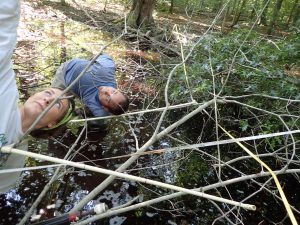
Yoga Instructor: Erin and Kenny in the Assessing Tree Canopy position. This particular position was used during the wetland mitigation/restoration assessment project.
As wetland scientists in our program (DNREC’s Wetland Monitoring and Assessment Program (WMAP)), we learn and work in multiple areas and across the entire State of Delaware. Besides hosting this blog, we bring the science to K-12 students with hands-on classroom learning, to scientists, engineers, and other state workers in the form of professional development opportunities, and to the general public by posting all of what we do and learn to the great world wide web. We do all of these things through our research on wetland health and on innovative restoration techniques.
As we close out the year, we like to provide a general summary of some of the things we have accomplished throughout 2018. We also have provided a few behind the scenes photos that might just experiment with possible alternate career paths for us wetland workers. So keep scrolling and enjoy the view.
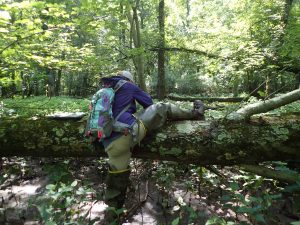
Children’s Books: Brittany is going on a wetland hunt, she’s going to catch a big one. She’s not scared. She can’t go over it? …
Assisted with the development of the Delaware Living Shorelines Website, DNREC Perspectives: Wetlands Wildly Beneficial website and Wetlands Work website
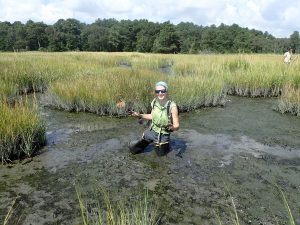
Hollywood Actor: Erin tries her hand at acting out the escape from the sinkhole in the Fire Swamp. Or is she acting?
Held the 2018 Delaware Wetlands Conference
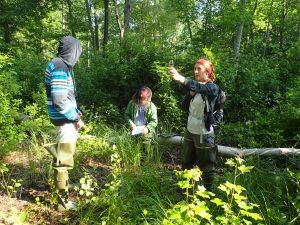
Meditation Guru: Kenny, Erin and Alex ponder the meaning of life and wetlands while trying to block out the mosquito distractions.
Thanks for joining us for the 2018 calendar year as we trekked through wetlands across the state, and we hope to see you in 2019! We would also like to thank all of the partners that have made our work possible. If you have any questions for us, you can get in touch with me at Brittany.Haywood@delaware.gov. Happy Holidays, and have a Happy New Year!
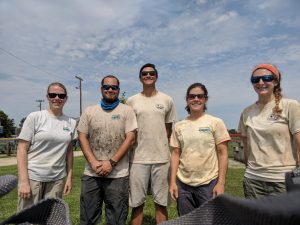
Naw, we’ll keep our own jobs. 2018 staff listed left to right: Brittany, Kenny, Alex (Seasonal), Alison, and Erin
Written on: December 3rd, 2018 in Wetland Assessments
Guest Writer: LeeAnn Haaf, Partnership for the Delaware Estuary
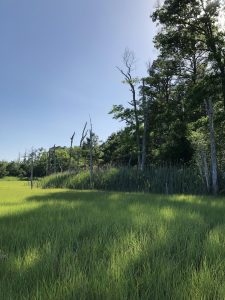
Figure 1. In the Delaware Estuary, there’s still a number of places where forests border tidal marshes, like this example from NJ.
Sea levels are rising in the Delaware Estuary– we’ve already observed its effects. Over the last couple decades, we have seen dramatic losses of tidal marsh acreage and documented the death of trees bordering those tidal marshes. We know that the last hope for a lot of marsh might be their migration upslope into forests. We suspect, however, that the forest might have to give way first.
At only a few millimeters a year, the small changes caused by sea level rise are difficult to see, especially in forests. How do we study those small changes? Luckily, trees still surviving along the tidal marsh edge have been recording environmental conditions since they were saplings (Figure 1). We can learn from the past.
Trees in our area grow wood in rings every year. In the spring, this wood is light and as fall approaches, the wood becomes darker before the tree stops growing for the winter (Figure 2). In good years, the tree might grow more. Likewise, in bad years, the tree might grow only a little, or not at all. Finding patterns of bad growth years allows us to figure out what events caused the trees to grow less– perhaps because it was a drought, maybe insects were eating too many of their leaves, or perhaps there was a big storm that flooded the forest with salty water.
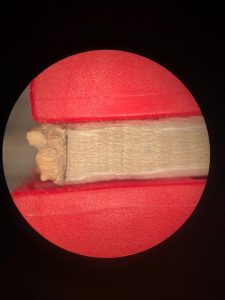
Figure 2. Growth rings in an American holly– on the left is bark separating the not finished 2018 growth ring. Can you spot which ring was laid 2013, after Hurricane Sandy?
If certain forests get flooded with a lot with salt water, and trees grow less because of it, they will not be as quick to recover from future floods. Groundwater and soil moisture will change. This means that the forest, and the types of trees in it, will also change.
Sensitive trees will die off first, then only certain trees will remain. Eventually, the margin of the forest will contain no living trees and the soils will be wet enough for marsh grasses to move in. Bad news for the forest, but great news for the marsh! My research focuses on developing an understanding of how trees adjust to coastal hazards (like storm surge or sea level rise) and what this might mean for the future of these forests (and the marsh!).
To study growth patterns in trees, a very small, narrow core is extracted from each study tree (Figure 3). So far, I have studied pitch pines (Pinus rigida) and American hollies (Ilex opaca), both of which are common near tidal marshes (elevations that are less than 3 m or 3.3 yd above sea level).
In the near future, I’ll expand these studies to red cedars (Juniperus virginiana) and maybe loblolly pines (Pinus taeda). I’m using x-ray fluorescence to help identify chemical elements that have been stored in the wood to pinpoint changes the trees may have experienced over time. Since salt water has unique chemicals compared to freshwater, we can get a sense if salt water flooding has become a more regular event through the tree’s life.
The most major flooding event in the last decade was undoubtedly Hurricane Sandy, which made landfall in NJ at the end of October 2012. In the Delaware Estuary surge tides peaked well over 2.5 meters (2.7 yards) for two consecutive days. Many of the trees I’ve been studying grew less in 2013, the year after Hurricane Sandy. This seems perplexing, but the hurricane hit at the very end of the growing season. The salt water flooding likely impacted the soil into 2013, so that trees struggled most the summer following the Hurricane.
I also see less or no growth in 1996. This year was actually one of the wettest years on record, and in other nearby locations, trees did remarkably well. Could too much rain in 1996 have led to overly wet soil in these low lying forests? I’ll be studying this more to see if there’s a coastal-connection.
Data from x-ray tests show trees can manage chemicals in their living tissues, and sometimes, whether conditions were good for uptake of micronutrients, like iron, calcium, and sulfur. When a forest floods with sea water, it introduces different components to the soil. This process can lead to an increase in the availability of iron, because of the extra moisture, as well as sulfur.
So far, I’ve tested four different trees using x-rays that varied from 4 to 34 meters from the marsh edge. Although these chemicals change from year to year, trees closer to the marsh seem to have consistently more iron and sulfur in their wood, but haven’t been growing any more or less than the other trees relative to their sizes. I’ll need more data to see if this patterns can be found in other trees, in other areas.
Although the overall short term prognosis of low lying coastal forests is still hazy, we’re working to better understanding the impacts of salt water flooding and sea level rise. So far, it looks like the changes to forest ecology caused by sea level rise are subtle. Trees can withstand quite a bit of environmental stress and are pretty resilient to change. It may take a couple decades to see more noticeable forest loss caused by sea level rise, but the impacts of storm surge could be more destructive and more immediate.
In general, forested areas may become wetter or swampier as sea levels rise, without very noticeable rates of tree stress or death caused by salt water. But if storm events bring and hold a lot of salty water in specific forests, we might see a lot of tree death in a short amount of time at that location (but maybe not others). If we cross walk both scenarios, we might see that forest loss and conversion into marsh will first happen mostly sporadically, starting where forests are most vulnerable to storm surge, then the marsh will slowly creep upslope where it can as sea level rises.
For more information about this project, please contact LeeAnne at lhaaf@delawareestuary.org.
Written on: December 1st, 2018 in Wetland Animals
by Kenny Smith, Wetland Monitoring and Assessment Program
Wetlands provide many services to us, like purifying our water, flood protection, and wildlife habitat. The animals that live in our wetlands can provide ample opportunities for outdoor activities like bird watching, fishing, and hunting. Delaware’s typical hunting and trapping seasons start in September and concludes at the end of January. Some of these species are migrants and pass through our wetlands on their way to wintering or breeding grounds, but most of these species are year round residents.
Continue on to learn about some of the hunting and trapping that you can do in the wetlands of Delaware and potentially partake if these opportunities seem interesting to you.
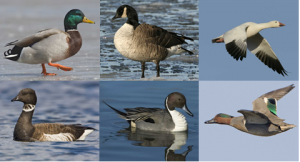
From left to right, top to bottom: Mallard, Canada Goose, Snow Goose, Brant, Pintail, Green-winged Teal Photo Credit: Audubon
Starting with the most common hunting activity in our wetlands is waterfowl hunting, this consists of ducks, Canada geese, snow geese, and brant. These species use a diverse array of wetlands in the state from tidal wetlands to wooded depression wetlands. Wood ducks prefer non tidal wooded wetlands where they can nest in tree cavities, while snow geese will roost along tidal wetlands on their way to wintering areas.
Most of the waterfowl hunting in Delaware is focused on the winter migrations of these birds, they leave the arctic breeding grounds and fly through Delaware on the way to wintering grounds in the southern U.S.
Based on Delaware Fish and Wildlife mail surveys, the estimated harvest of ducks last year was just over 40,000 while Canada geese harvest was about 20,000, and snow geese was 11,000. This survey estimates that around 5,000 people enjoy waterfowl hunting in the states wetlands every year.
Muskrat are a year round resident of tidal salt marshes throughout the state, they create small mounds in salt marshes where they live. Muskrat are members of the rodent family but are actually omnivores and will consume vegetation but also frogs and fish.
They are one of the more common species to be trapped in Delaware and have been a Delaware tradition since colonization, with the meat and fur being the objective. The furs are sought after for clothing manufacturing, mostly in China, Russia, and Korea now that the North American fur demand has decreased significantly.
The meat from muskrat is a local delicacy and is often sold to local restaurants, local wild game dinners, or consumed by the trapper. If you are daring, some Delaware restaurants still serve muskrat and it can still be found at local butcher shops.
The non-waterfowl gamebirds I am referring to are the rails, snipe, coot, and the gallinules and moorhens. Most of these birds migrate through Delaware, with rails being the exception being year round residents.
Rails are a secretive marsh bird that inhabits our tidal salt marshes, with 4 different species being the target of sportsmen. The clapper rail is the most common rail found in Delaware, with the sora, the Virginia rail, and the King rail being the least common. Snipe are the next bird that hunters can target, and this is not a childhood prank. Snipe are actually a very common bird that hunters pursue. These birds usually can be found around open marshes and mud flats of our coastal wetlands. In the Delaware Fish and Wildlife mail surveys, they estimated that almost 400 rail and about 40 snipe were hunted last year.
Coots, gallinules, and moorhens are not as regional hunted as they are in other parts of the country but we do have them and they legally can be harvested. Coots can be found along marsh edges and can create large flocks on open water while moorhens and gallinules are more solitary and can be found along edges of marshes or ponds similar to rails.
Bullfrog and Snapping turtles are year round residents and can be found in many of our freshwater wetlands throughout the state. Bullfrog hunting is slightly different from any other hunting that happens in wetlands, you are allowed to do it at night, you don’t use a trap or gun, and the frog season runs from May 1st to September 30th. Instead you can use a light at night in the warmer months and hunt frogs with a spear or gig. Bullfrog hunting is very common in the southern U.S., and is still practiced by many in the Delmarva region. Bullfrog hunting can be a very inexpensive hunting endeavor since only a light and gig are required once you have the proper license.
On the flip side snapping turtle trapping is a very labor intensive adventure and you will need a lot more equipment. You can still try and use a spear, gig, or net but it is usually not as successful as using traps. The snapping turtle season runs from June 15th to May 15th and each turtle has to be a minimum of 11 inches on the curvature of the top shell. Bullfrog and snapping turtle are the 2 most common herpetological prey for hunters to pursue and are abundant throughout the state.
Highlighted were just some of the opportunities to hunt or trap in the wetlands of Delaware, check the Delaware Hunting guide for the proper seasons and laws before partaking in these activities. You will need to purchase a hunting or trapping license and tag along with a friend or family member and enjoy the outdoors. Below are some online resources to help you if you would like to try hunting or trapping in Delaware.
Written on: December 1st, 2018 in Wetland Animals
by Erin Dorset, Wetland Monitoring & Assessment Program
In the spring and summertime, Delaware’s wetlands are teeming with wildlife. Frogs and toads are heard in chorus, calling for mates; turtles are observed slowly walking through the woods or basking on logs and rocks in the water; snakes are seen slithering across mosses or trees. But by late fall, many of these fascinating creatures seemingly disappear, making winter wetlands seem relatively quiet and still. Have you ever wondered where the reptiles and amphibians go when the days get short and cold, and how they survive freezing temperatures?
In the winter, many of these wetland animals undergo a process known as brumation. During brumation, animals will substantially lower their heart rates, activity levels, body temperatures, and metabolisms. Because their energy demands become so low in this state, they do not eat and barely breathe at all! However, some animals in brumation may still show some movement, particularly during warmer spells. This is why they are said to brumate, not hibernate, as hibernating animals typically do not wake or move around in the middle of their sleeping period. The place where they spend the winter is called a hibernaculum.
Many of these wetland creatures handle brumation a bit differently—read on to find out more!
Delaware’s wetlands are home to many aquatic turtles, such as the Northern diamond-backed terrapin (Malaclemys terrapin terrapin) and the Eastern painted turtle (Chrysemys picta picta), as well as many terrestrial turtles, such as the Eastern box turtle (Terrapene carolina carolina) and the spotted turtle (Clemmys guttata). As winter approaches, aquatic turtles usually bury themselves in mud or under banks of water bodies to brumate, while terrestrial turtles typically go underground in burrows.
Hatchlings of some species may spend the winter within the nest where they were born. Because they are often under water or fully buried, they are unable to get a lot of oxygen. The oxygen the turtles do need comes from the few breaths they do take as well as from stored energy within their bodies. Unfortunately, this breakdown of stored energy without much oxygen can create harmful compounds within the body, such as lactic acid. Some turtles, though, such as Eastern painted turtles, have the really cool ability to neutralize the acid using the calcium carbonate in their shells¹!
Because turtles usually bury themselves, they are often able to escape contact with snow and ice. However, sometimes ice crystals can form in their overwintering spaces, creating a heightened risk of freezing. Turtles have an awesome way of dealing with this. Some species, such as the diamond-backed terrapin, are freeze-tolerant, meaning that they can still live for a certain amount of time even if some of their body fluids have frozen.
Other species use a strategy known as supercooling, where body fluids remain unfrozen up to a certain point even when the temperature has dropped below the freezing point². Once the days start to get longer and the temperature is consistently higher, the light and warmth act like biological alarm clocks; the turtles will know that spring has sprung and that it’s time to come out.
Much like turtles, frog species that spend a lot of their time in water, such as the Southern leopard frog (Rana sphenocephala utricularia) and the American bullfrog (Rana catesbeiana), will overwinter underwater. These frogs live off of extra energy stores within their bodies that they built up specifically for the winter months.
However, unlike turtles, frogs cannot bury themselves completely under the mud; rather, they can only bury themselves partially. With their skin exposed above mud, frogs can often get all of the oxygen they need to survive the winter through their skin!
When dissolved oxygen levels in the water drop, overwintering frogs are faced with a serious challenge, as they cannot survive more than a few days without the right amount of oxygen present. If such a challenge occurs, some frogs have the capability of sensing it and can undergo what is called behavioral hypothermia. In other words, the frogs will actually move to colder water in order to further lower their metabolism, which ends up increasing the amount of oxygen in their blood to keep them alive longer. But, if there is plenty of oxygen in the water, the frogs can actually move to a nearby spot with relatively warmer water³.
Terrestrial or land loving frogs have a different strategy to deal with winter. They will find a damp area in underground burrows, under leaf litter, or in deep crevices to escape freezing temperatures and frost.
Some frog species may actually overwinter at shallower depths than others; species that do this, such as the wood frog (Rana sylvatica), can tolerate freezing. These frogs use high concentrations of glucose (simple sugar) as a sort of “antifreeze” in their organs to keep them alive while parts of their body become frozen. Because of this, they can stay alive even while partially frozen with no breathing or heartbeat4! Once temperatures warm up, their heartbeat and breathing return to normal.
Many different snake species can be found in and around Delaware’s wetlands, including the common ribbonsnake (Thamnophis sauritus sauritus), Eastern ratsnake (Elaphe alleghaniensis), Northern black racer (Coluber constrictor constrictor), and Eastern gartersnake (Thamnophis sirtalis sirtalis).
To escape the cold, these snakes overwinter in sheltered places such as burrows, rock crevices, and wood piles. Interestingly, many snakes will brumate in the same place each year, and often, they are not alone. It is common for snakes to spend the winter in a hibernaculum with other snakes, either of the same species or multiple different species.
Although the snakes may move a bit and drink a little water, they mostly remain within the hibernaculum with a slowed heartbeat and metabolism and no food until the weather is consistently warmer. Within their hibernaculum, though, some snakes may move around to relatively warmer spots to help increase their body temperature5.
¹Jackson, D. C. 2000. Living without oxygen: lessons from the freshwater turtle. Comparative Biochemistry and Physiology Part A, 125: 299-315.
²Baker, P. J., Costanzo, J. P., Herlands, R., Wood, R. C., and R. E. Lee, Jr. 2006. Inoculative freezing promotes winter survival in hatchling diamondback terrapin, Malaclemys terrapin. Canadian Journal of Zoology, 84: 116-124.
³Tattersall, G. J. and G. R. Ultsch. 2008. Physiological Ecology of Aquatic Overwintering in Ranid Frogs. Biological Reviews, 83: 119-140.
4Storey, K. B. and J. M. Storey. 1984. Biochemical adaptation for freezing tolerance in the wood frog, Rana sylvatica. Journal of Comparative Physiology B, 155: 29-36.
5Macartney, J. M., Larsen, K. W., and P. T. Gregory. 1989. Body temperatures and movements of hibernating snakes (Crotalus and Thamnophis) and thermal gradients of natural hibernacula. Canadian Journal of Zoology, 67: 108-114.
Written on: December 1st, 2018 in Wetland Animals
Guest Writer: William Koth, Delaware State Parks
Bryozoans may be one of our most overlooked and underappreciated animals. Known as “Moss Animals,” bryozoans are small, simple animals rarely growing more than 1/25th of an inch in length. However, most bryozoans form colonies that can vary greatly in number, form, and size.
Each individual animal, or zooid, has a simple body style, usually round or oval in shape with a single opening that serves as both a mouth and an anus. Bryozoans lack any respiratory, excretory,or circulatory systems, but have a central nerve ganglion that allows the animal to respond to stimuli. They feed using small tiny ciliated (hair-like) tentacles that the surround the opening and push food through the it into the gut. In some species, and during certain life periods, these tentacles can be used for simple movement. Most species, however, spend the majority or all of their lifespan immobile.
The vast majority of Bryozoan species are marine animals. Of nearly 5,000 species, less than 90 have been identified in freshwater environments, and only 24 freshwater species in North America (so far).
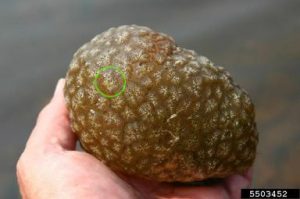
The green circle highlights a rosette or colony of bryozoans. Photo credit: Leslie J. Mehrhoff (bugwood.org)
In the freshwaters of Delaware, you are most likely to encounter the native Magnificent Bryozoan (Pectinatella magnifica). This colonial species forms jelly-like “green blobs” on underwater vegetation, branches and other structures. They may also form free floating round colonies. The small visible rosettes on the surface of the colony are groups of 12-18 individual animals.
Although the Magnificent Bryozoan reproduces both sexually and asexually, the main way the colonies form is when the existing individual animal or zooid breaks away or buds asexually forming a twin. As they reproduce, they multiply into an ever growing sphere as the individuals point their mouths outwards to take advantage of available food. Meanwhile, the zooids excrete gelatinous material to give the sphere interior support.
Completely new colonies can also form asexually from small statoblasts (a group of cells encased in a hard covering to protect them from freezing or other harsh conditions). These statoblasts can float in the current, or settle to the bottom where they eventually grow into an individual zooid. These individual zooids can use their ciliated tentacles to move about in the water. They will eventually begin dividing and form a new colony. Smaller free floating colonies have been observed to use the ciliated tentacles in unison to move toward or away from stimuli.
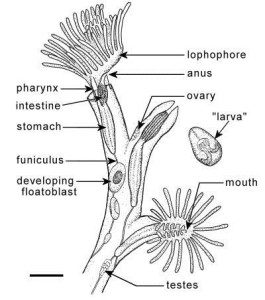
Two bryozoan individuals and their anatomy. Dr. Timothy S. Wood (Department of biological sciences, Wright University)
The Magnificent Bryozoan actively feeds on suspended organic material, zooplankton, and algae. In this way it can be considered a filter feeder and may, in some instances, increase water clarity. Individual animals on the colony are clear or opaque. It is speculated that the green color of the colonies stems from ingested algae.
The Magnificent Bryozoan is native to Delaware, its native range extends from the Mississippi eastward to the Atlantic Coast from Ontario southward to Florida. Invasive outbreaks have been occurring in Europe since the 1930’s and west of the Mississippi since the 1950’s. The ecological impact of these invasions is still being studied, but colonies and groups of colonies have started to block some smaller waterways, ditches, and drainpipes. Colonies have been recorded up to 4 feet in Virginia, although the typical size found in Sussex County swamps, ponds and waterways is an inch to about a foot in diameter.
Encountering a colony of these animals can be a great experience. Trap Pond State Park staff receive several inquiries about these creatures each year. Most folks guess that they are some type of algae or fungus. Other guesses include freshwater jellyfish or fish eggs. Almost everyone is surprised to find out it is actually a colony of animals.
The staff recommend that you take full advantage of discovering one of these unique creatures. They do request that you not dislodge attached colonies, and not to keep them out of the water for more than a few minutes at a time. Lift it up, feel its surface, feel its weight, smell it. If you have a magnifying glass, take a look at the individual zooids on the surface. They are amazing animals that deserve a closer look and a little more appreciation!